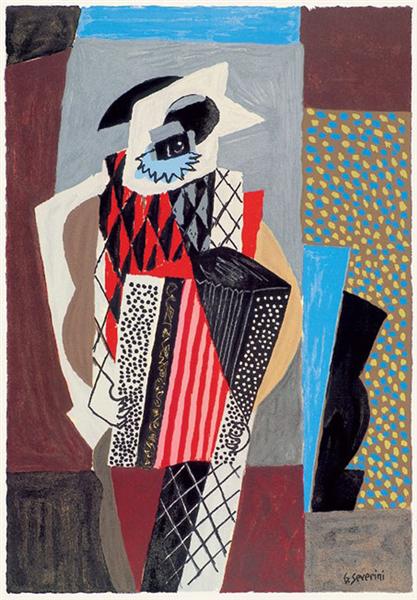Description
The "Arlequín" painting by Gino Severini, made in 1965, is a work that encapsulates the essence of an artist who has sailed by various currents of the art of the twentieth century, particularly cubism and futurism. Severini, recognized as one of the most prominent figures of these avant -garde, applies in this piece a visual treatment that defies the traditional perception of space and form, establishing a constant dialogue between the figure and the background, as well as with the spectator itself.
In "Arlequín", the central character, an harlequin, which historically has been a symbol of art comedy, is presented with a dynamic and energetic composition. The figure is composed of geometric shapes that transmit not only movement but also a vibrant vitality. The choice of harlequin as a theme is a reference rich in meaning, evoking the duality of life and theatrical representation, while hinting the complexity of the human being in his aesthetic and emotional experience.
The use of color in this work is essential to understand its visual impact. Severini opts for a palette of intense colors, predominantly the red, blue and yellow tones, which not only awaken a feeling of joy, but also create a visual contrast that magnetizes the observer's attention. These colors are intertwined with the geometric shapes of the harlequin, achieving an almost vibrant effect, which resonates with the energy of dance and rhythm, fundamental qualities of the essence of the character represented.
From a compositional perspective, "Arlequín" shows a balance between the character and the surrounding space. The asymmetric disposition of the forms, together with the fragmentation of the harlequin, offers an approach that suggests movement and fluidity, key characteristics of futurism that Severini, as one of its representatives, knew how to integrate into their work. This radical approach to the decomposition of the figure in planes and nuances instigates the viewer to reconsider the perception of what he observes, when questioning the relationship between space and the figure.
However, the work also has a palpable emotional load. The harlequin, traditionally a melancholic figure after its mask, reflects an internal contradiction that goes beyond mere representation. This duality between what it shows and what it hides can be interpreted as a comment on human existence, where the public and private facet are often opposite.
Although "Arlequín" is a later work in Severini's career, you can see how the artist continues to work on the principles that govern his practice since his beginnings. Through it, Severini continues to explore fundamental issues of identity, perception and the ephemeral nature of art. The piece is part of a tradition of artists who have reinterpreted the figure of the harlequin, a character full of symbolism and that, in this representation, is transformed into a celebration of color and shape.
In conclusion, "Arlequín" by Gino Severini is much more than a representation of a character; It is a complex exploration of human emotions, identity and vibrant energy of modern art. The work continues to challenge and stimulate the critical thinking of those who enter their visualization, reaffirming Severini's mastery by combining shape, color and symbolism in one painting.
KUADROS ©, a famous paint on your wall.
Hand-made oil painting reproductions, with the quality of professional artists and the distinctive seal of KUADROS ©.
Art reproduction service with satisfaction guarantee. If you are not completely satisfied with the replica of your painting, we refund your money 100%.

